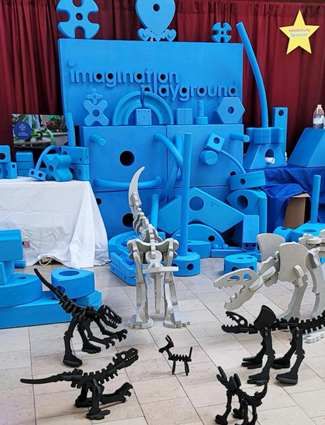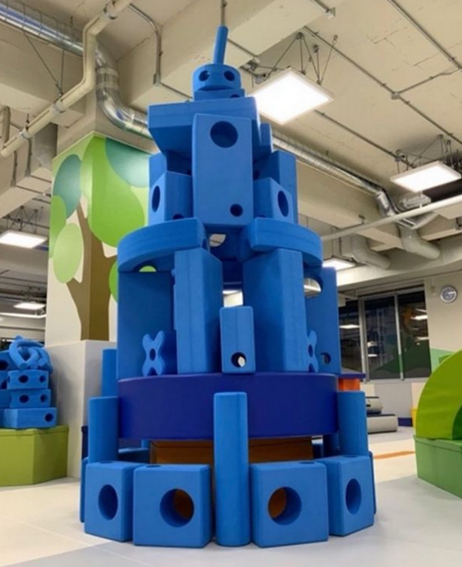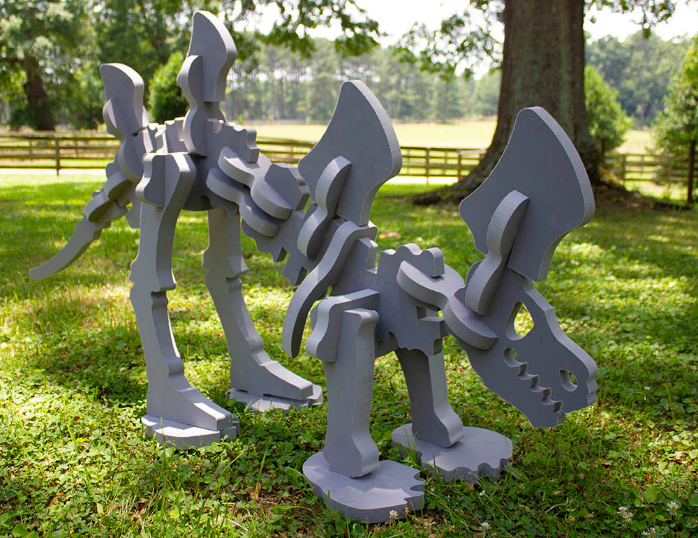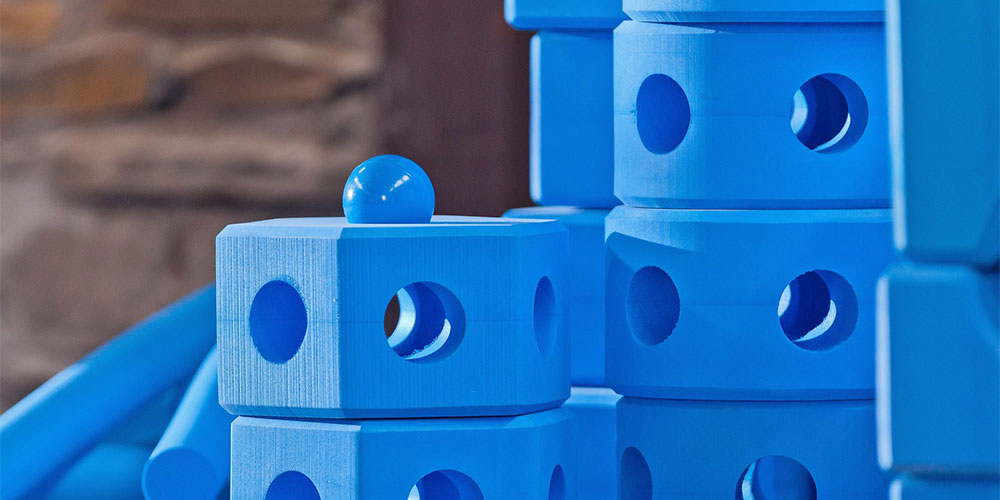Imagination Playground blocks are pretty dang neat.
Neat is a fitting adjective and an accurate first impression, for sure. But there’s much more behind the psychology and application.
To get concrete, this is a play system that enhances children’s creativity, social learning, problem-solving skills, and physical recreation. In a nutshell, Imagination Playground connects imagination with intelligence so kids can play while they grow academically and socially.

If the company name didn’t make it clear, the product certainly does: These tools place a kid’s imagination as the cornerstone of learning. What’s the Imagination Playground philosophy on creativity and inventiveness as a driving force behind education?
Our blocks were inspired when David Rockwell, a renowned award-winning architect, was playing with his children and a bunch of cardboard boxes. He was struck by how many things their imagination could build with simple boxes. Each time the game shifted, the box became something else. He saw and appreciated the power in imaginative, loose-part play.

But it obviously went beyond that — beyond just play. Watching a child bring their ideas to life can help build a child’s confidence as they navigate unforeseen complications and find solutions to overcome. Having a creative venue to expressively play is critical to a child’s self-esteem, development, and overall psychological wellness.
As builders ourselves, we are still constantly impressed by the creative structures that children imagine and bring to life with their Blue Blocks. Adults can stand back and truly watch as the gears turn in the builders’ heads as they articulate their vision, defend their ideas, give and take instruction, and accomplish their end goal.
We have seen our Blocks used in play therapy sessions to assist in building communication skills and teaching life skills such as self-control, respect, and empathy. The best part of loose-part play is that it is so open-ended that it can be used as an educational tool to those of all abilities, ages, and communication levels.
Let’s face it: Teachers have a state-standard checklist to complete. What core disciplines (science, math, SEL) do Imagination Playground blocks instill?
Loose-part play can be easily integrated into lessons on pretty much every subject, especially when you have durable, waterproof parts. We have a full curriculum available full of ideas on how to use the Blue Blocks in all aspects of STEAM learning.
Some popular topics we commonly see covered from educators, family center and childcare directors, and even parents are using their Blocks for lessons in math, reading, and science. Such as, using the Blocks to re-create a building or significant structure from the story they are reading, counting the Blocks or taking their measurements, and lessons on gravity, cause and effect, and engineering.
We have seen that children especially love lessons that incorporate water into the Block play, like learning about density with the floating Blocks, or gravity as they use water with the arch and chute Blocks to have balls travel down through the course.
When students use Imagination Playground products, they’re making fortresses, or hover crafts, or mythical creatures, so in essence, they’re playing. But at the same time, they’re learning. In your view, how important is play in the developing child?
Play has been scientifically proven time and time again to be the primary means through which young children develop and learn. Our Big Blue Blocks encourage child-directed play in a larger-than-life setting that forces them to think both creatively and critically, collaborate with other builders, and communicate their thoughts to accomplish their end goal. In a nutshell, they need to problem solve.

In today’s age of standardized testing, rigorous hours of lessons, and the homework that spills over into the evening, play is, perhaps, more important now than ever before. I would also say that as schools shift away from paper books and onto screens, the idea of stepping away from an electronic device and using your hands and body to build is also of paramount importance.
Coincidentally, those aspects of building large structures are also the 4 Cs of STEAM learning. Learning how to effectively express themselves, solve problems, and compromise with their peers are all vital life skills that can’t be taught by sitting at a desk.
Physical play promotes brain health, growth, and development for people of ALL ages, but especially in adolescents. Through play, children observe and learn about the world around them.
We’re curious: How do parents react when they see Imagination Playground in their child’s classroom?
That is a great question, and the answer is even better. Parents always love seeing their children play and learn with toys. There is a nostalgic feeling that comes with watching your kids play with the same type of toy you did. It also doesn’t hurt that the blocks are handcrafted in the USA with the finest and safest materials available — that lends peace of mind. But Imagination Playground takes it a step further. Because the Blocks are so large and immersive, we often find that parents join in the play.
Sure, they use excuses like, “I am not sure he/she can reach that high” or “Let me show them how to make that more stable,” but in the end, the parent starts playing. The size of the Blocks gives implicit permission for an adult-size builder to engage. And then the benefits really start to happen. Parents engaging with children and teaching through play is fascinating to watch. It is like adding rocket fuel to the learning process. It is so rewarding and makes what we do all worth it.
So, to answer your question, when a parent walks into their child’s classroom, school library, or playground area and sees the Big Blue Blocks, they are typically intrigued and will gravitate toward them. The parents ask questions on how they’re used, what they’re made of, and well, of course, they have to pick up a Blue Block to see for themselves!
Tell us about Block Champions. What’s that program all about?
Almost four years ago, we launched our Block Champion program to recognize and spotlight the amazing builders who take Blue Block play to the next level. These builders find ways to use Blocks beyond what we ever conceptualized and, as a result, positively impact the community around them.
Our Block Champions are nominated by their peers as inspirational leaders who enthusiastically use their Blue Blocks to engage children in learning and fun. Especially through the pandemic, we saw museum directors, teachers, and camp leaders go above and beyond to provide play opportunities during the time of isolation and dysregulation. There were organizations, such as the Boston Children’s Museum, that created outreach opportunities and programs to safely get loose-part play into the hands of children who needed it.
Our Block Champions tend to be those who have found needs in their community and are taking the initiative to help fill them. From a lack of playgrounds available, to the necessity for more one-on-one educational time, they identify the need and drive a solution through their own force of will.
They are innovators. They are philanthropists. They are advocators. They are more valued than they may realize, and we want to help contribute to their mission. We try to drive awareness to their cause and do what we can to assist. Our Block Champions truly belief and embrace the power of loose-part play!






